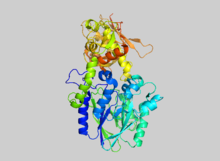| 5′-nucleotidase | |||||||||
|---|---|---|---|---|---|---|---|---|---|
 Human ecto-5'-nucleotidase (CD73): crystal form I (open) in complex with adenosine[1] | |||||||||
| Identifiers | |||||||||
| EC no. | 3.1.3.5 | ||||||||
| CAS no. | 9027-73-0 | ||||||||
| Databases | |||||||||
| IntEnz | IntEnz view | ||||||||
| BRENDA | BRENDA entry | ||||||||
| ExPASy | NiceZyme view | ||||||||
| KEGG | KEGG entry | ||||||||
| MetaCyc | metabolic pathway | ||||||||
| PRIAM | profile | ||||||||
| PDB structures | RCSB PDB PDBe PDBsum | ||||||||
| |||||||||
5′-Nucleotidase (EC 3.1.3.5) is an enzyme which catalyzes the phosphorylytic cleavage of 5′-nucleotides.[2] Although originally found in snake venom,[3] the activity of 5'nucleotidase has been described for bacteria and plant cells, and is widely distributed in vertebrate tissue.[4] In mammalian cells the enzyme is predominantly located in the plasma membrane and its primary role is in the conversion of extracellular nucleotides (e.g. 5'-AMP), which are generally impermeable, to the corresponding nucleoside (e.g. adenosine) which can readily enter most cells.[5] Consequently, the enzyme plays a key role in the metabolism of nucleotides.
The enzyme has a wide substrate specificity for nucleotides and has been shown to hydrolyze 5'nucleotides rapidly, ribose-5-phosphate slowly, and other phosphate esters extremely slowly (if at all).[6]
The enzyme catalyses the following reaction:
- a 5′-nucleotide + H2O ⇌ a nucleoside + phosphate
The 5′-nucleotidase-catalyzed reaction of an AMP nucleotide to adenosine nucleoside is shown below:

- ^ Knapp K, Zebisch M, Pippel J, El-Tayeb A, Müller CE, Sträter N (December 2012). "Crystal structure of the human ecto-5'-nucleotidase (CD73): insights into the regulation of purinergic signaling". Structure. 20 (12): 2161–73. doi:10.1016/j.str.2012.10.001. PMID 23142347.
- ^ Fleit H, Conklyn M, Stebbins RD, Silber R (December 1975). "Function of 5′-nucleotidase in the uptake of adenosine from AMP by human lymphocytes" (PDF). The Journal of Biological Chemistry. 250 (23): 8889–92. doi:10.1016/S0021-9258(19)40668-6. PMID 1194267.
- ^ Reis, Julian (1934). "Nucleotidase and its relation to the deamination of nucleotides in the heart and the muscles". Bulletin de la Société de Chimie Biologique. 16: 385–399.
- ^ Sidorov VP (1975). "[Factors affecting the frequency of exploratory thoracotomies in lung cancer]". Grudnaia Khirurgiia (2): 84–87. PMID 1132794.
- ^ Sunderman FW (1990). "The clinical biochemistry of 5'-nucleotidase" (PDF). Annals of Clinical and Laboratory Science. 20 (2): 123–39. PMID 2183704.
- ^ Koshland DE, Springhorn SS (July 1956). "Mechanism of action of 5'-nucleotidase". The Journal of Biological Chemistry. 221 (1): 469–76. doi:10.1016/S0021-9258(18)65265-2. PMID 13345835.
